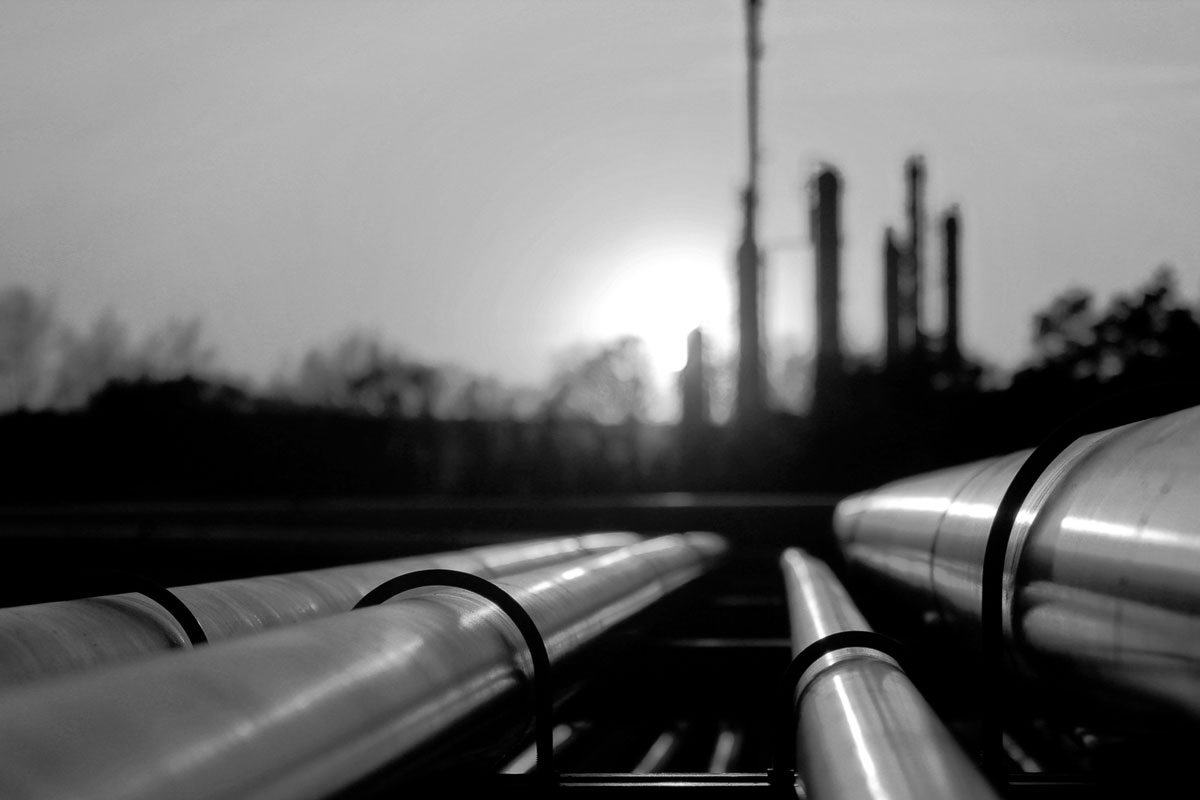BVB best oil and gas performers
With profits totalling over RON 5 billion and an aggregate turnover of over RON 45 billion, the seven companies making up the oil and gas industry on the Bucharest Stock Exchange (BVB) mark, at sector level, another year of growth. After a 2016 that represented an exit from the crisis, figures brought by the publication of preliminary financial results for 2017 indicate a continuation of the positive trend in the sector, supporting the positive expectations of specialists for 2018.
The local oil and gas industry is in full upswing, if we take into account the financial results reported by companies of the sector listed on the Bucharest Stock Exchange (BVB) for 2017. Although they can still suffer changes (the results published being only preliminary), the figures reported by the seven companies in the field, traded on BVB, show that the industry has taken another significant step forward on the recovery path. Thus, in 2017, the aggregate turnover achieved by the seven companies exceeds the threshold of RON 45 billion, by no less than 20% higher than the turnover posted by the same seven companies in 2016; at the same time, the sum of profits recorded by the same seven companies was approximately RON 5.14 billion, by more than 70% higher than total profits of 2016 (see the charge ‘Yet another growth year for the oil and gas industry on BVB’).
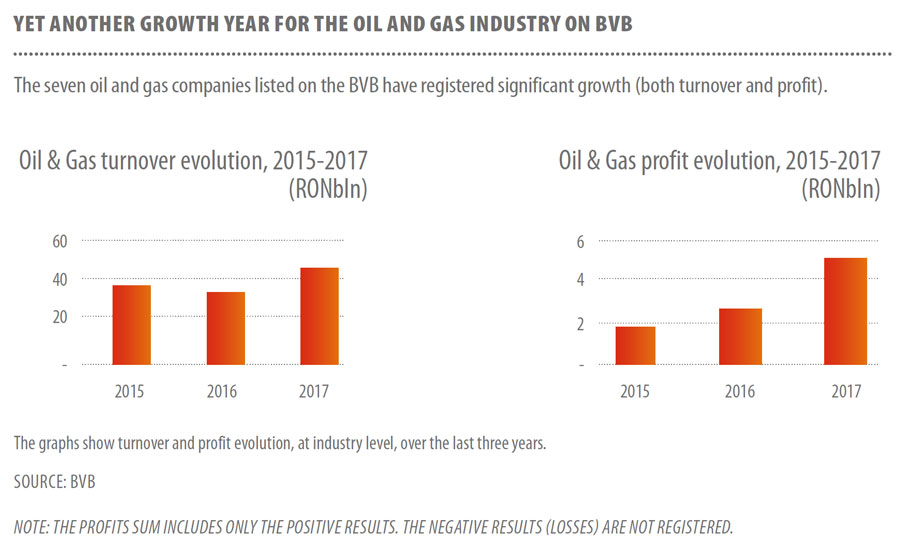
It should be noted that, unlike the previous two years, none of the profile companies posted losses. Even Rompetrol Well Services – company part of The Rompetrol Group owned by KazMunayGas – managed to be in the black in 2017 (see the table ‘Profits in the oil and gas sector on BVB’).
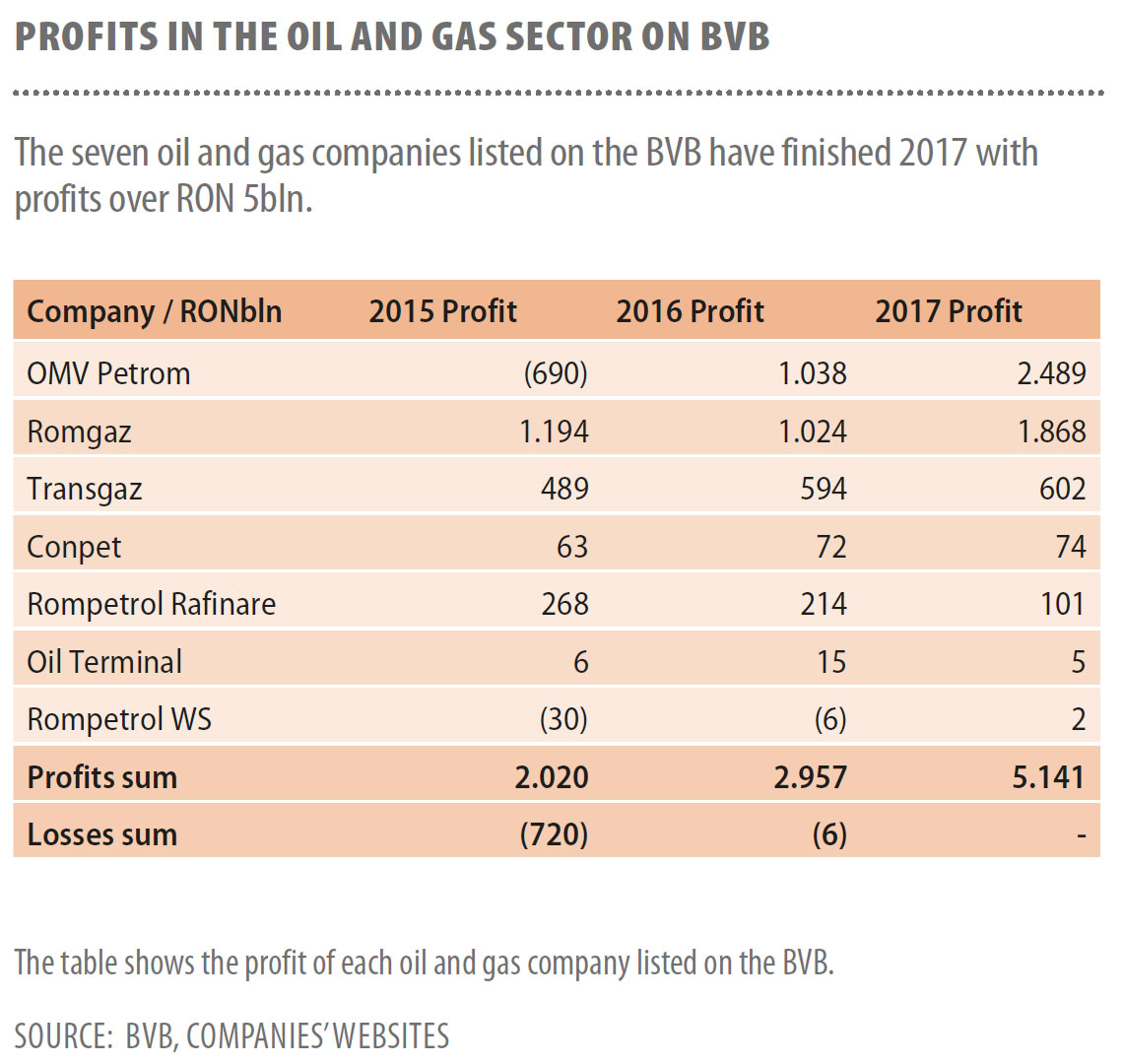
Leaders of the sector: OMV Petrom and Rompetrol Rafinare
The main drivers of these positive evolutions at industry level are the companies OMV Petrom (ticker SNP) and Rompetrol Rafinare Constanta (RRC); these two companies accounted for more than 80% of the total turnover at industry level.
However, also SNP stands out by the fact that it makes alone almost half of the aggregate profit at industry level (see the table ‘Profits in the oil and gas sector on BVB’). The largest player in the local profile industry and one of the players of regional importance in the field, SNP (OMV Petrom) moved from losses of RON 690 million in 2015 to a profit of over RON 1 billion in 2016, reaching a profit of approximately RON 2.5 billion in 2017; at the end of this latter year, the company also reported a turnover of RON 19.4 billion, up approximately 16% compared to the turnover reported in 2016 (see the chart ‘Growing turnover for the key players in the industry’). Its growth is determined by the higher sales in all business segments due to improved economic conditions.
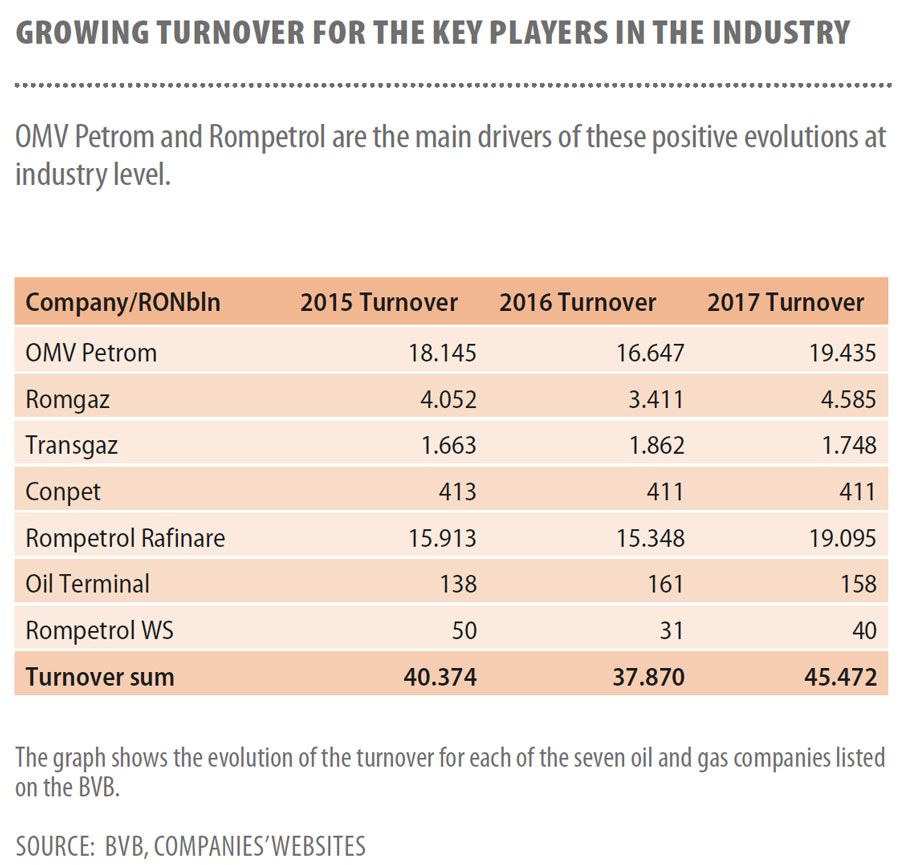
A strong positive effect was brought however by the improved costs. Thus, production costs at Group level stood at USD 10.90/boe in 2017, by 7% below the level in 2016, mainly due to elimination of the tax on special constructions, lower costs with materials and services and as an effect of administrative reorganization; the production cost in Romania was USD 10.89/boe, by 8% lower than in 2016. On the other hand, the average daily hydrocarbon production at Group level was 167.6 thousand boe/day (in Romania being 160.6 thousand boe/day, by 3% below the level in the previous year). Total oil, gas and condensate production at Group level was also lower than in 2016, due to natural decline, sale of marginal fields and intervention to key wells in Kazakhstan. Hydrocarbon sales volume at Group level also recorded a decline by 3% compared to 2016, due to a decrease in volumes, in both Kazakhstan and Romania.
On the other hand, total sales of refined products at Group level stood at 5.07 million tons, by 3% higher than the level recorded in 2016, which reflects especially the higher demand for products in the domestic market. At the same time, retail sales at Group level were by 6% higher than in 2016, reaching the level of 2.7 million tons, as a result of the same positive evolution of demand in the domestic market (see the chart ‘OMV Petrom production indicators’).

The increased demand was moreover one of the main drivers for the financial results of the second giant of the profile industry on BVB, i.e. Rompetrol Rafinare; the consolidated results of Rompetrol Rafinare (including here Rompetrol Rafinare SA, Rompetrol Downstream SRL, Rompetrol Gas SRL, Rompetrol Quality Control SRL, Rom Oil SA, Rompetrol Logistics SRL, Rompetrol Petrochemicals SRL) indicate for 2017 a gross turnover of over USD 4.15 billion (the equivalent of over RON 19bn), up 16% compared to 2016 – calculated in USD (calculated in RON, the increase in turnover in 2017 vs. 2016 is by around 24%, due to RON depreciation).
In terms of profit, RRC had a worse year than in 2016. The net profit reported was USD 21.9mln, by 62% lower than in 2016, when it reported USD 57.1mln; we are talking however about a decline determined by an extraordinary non-repetitive transaction given by the change of accounting policy for tangible assets, namely the shift from the cost model to the revaluation model. On the other hand, from here on, this evaluation model will provide a more transparent image of the assets of companies within the Group.
The company had a good evolution in a favourable economic environment. Brent oil prices moved from the beginning of 2017 until March around USD 55/bbl; in the following months, until July, they were characterized by a rising volatility, leading to pluses and minuses of up to USD 5/bbl, dropping even below the threshold of USD 45/bbl in the second half of June – the minimum of 2017. In this context, a number of unplanned stops and the higher demand at global level led to a decline of stocks and increasing fears that the market might not be supplied enough. Against this background, OPEC’s actions, as well as those of oil producers outside the cartel have decisively contributed to the strengthening of demand and led to a rebalancing of prices.
In terms of refined products, 2017 was a good year for automotive diesel markets, largely due to increased demand; in addition, the decline in stocks in Europe and the US has led to a significant reduction in the permanent global inventory. The impact of Hurricane Harvey and the fall in US diesel supply on the global market led to a significant increase in the value of the differences between diesel prices and Brent crude oil prices. The magnitude of these variations has been felt most strongly in Europe – a market on which large volumes of average distillates from the United States are absorbed.
In this environment, Petromidia refinery managed to register results at historical levels for a number of the key technological and operational indicators. Thus, the amount of raw material processed was approximately 5.66 million tons, with an equivalent of 16.8 Kt per day – up 5% vs. 2016 and a historical high from 1979 to date; it also recorded a record level of motor gasoline production (1.46 million tons) and diesel fuel production (2.74 million tons). Equally spectacular evolutions in terms of amounts processed were also recorded by Vega refinery – the oldest refinery in Romania (see the charge ‘Rompetrol production indicators’).
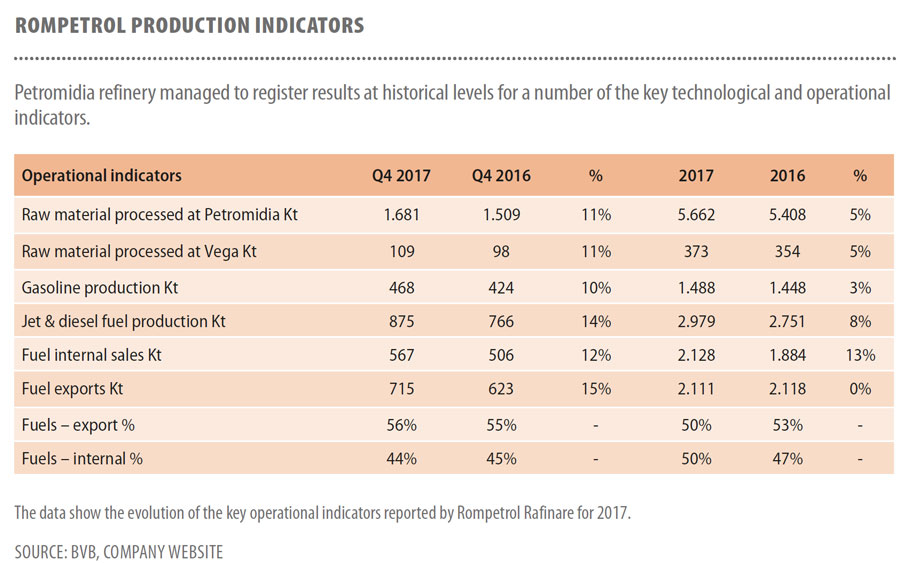
Anchors of the sector: SNG and TGN
While SNP and RRC are by far the largest companies in the field – and those that set the tone at national level, Romgaz (SNG) and Transgaz (TGN) are the companies that give a consistent plus of stability, when it comes to profits achieved. In other words, although at great distance from leaders in terms of turnover, SNG and TGN represent a healthy and stable component of the market when it comes to profits.
Thus, Romgaz for example reported for 2017 a net profit of approximately RON 1.9 billion, up 82% compared to 2016 and by 54% higher than the profit reported in 2015, at a turnover of RON 4.6 billion – which also increased by 34% compared to 2016. The growth comes amid an increase by 32% in revenues from gas sales – from both own production and purchased. An important driver of turnover growth is also the increase in revenues from electricity sales (38%) and revenues from storage services (by 46%). According to the report published on BVB website, the operational and financial performances of Romgaz in 2017 are the best from the listing on the two markets (BVB and LSE – admission to trading on the two stock exchanges taking place in 2013).
Gas production stood at 5.158 million cubic meters, by 22% (or 939 million cubic meters) higher than production achieved in 2016, growth being stimulated by the lower temperatures from the beginning of 2017 and an increase in gas demand for electricity production (see the table ‘Romgaz production indicators’). The increase by 14.5% in the amount of electricity produced by Romgaz in 2017 was determined on the one hand by the lower production from hydro and renewable sources, amid an extended heat wave, and on the other hand by the repair and maintenance programs at some thermal power groups and temporary lack of availability of certain production capacities in the thermal power and nuclear areas.

Revenues from gas storage increased by over 46%, to the (estimated) level of RON 505mln, following the sale in 2017 of an amount of own gas from the storage facilities higher by 56%. Revenues from electricity sales were also on the rise, reaching the value of RON 464mln, by 38% higher than those achieved in 2016 – the market share in the electricity production segment being 2.95% according to Transelectrica information.
It should be noted that at the end of 2017 the company had cash, bank deposits and government bonds of RON 3 billion, lower than the level recorded at the end of 2016 (when the level of liquid assets was RON 3.17bn). The decline was generated by the distribution of additional dividends in 2017; we are talking however about an amount that, even in (slight) decline, keeps the company in a very good financial position, leaving room for a potential distribution of additional dividends in 2018 as well.
The same still good financial situation is also visible in Transgaz’s case. That despite certain slightly negative evolutions of some of the key financial and accounting indicators. Thus, Transgaz’s total assets reached at the end of 2017 the level of RON 5.25bn, by 2% lower than the value recorded in 2016, following a reduction of fixed assets by 2.13% and the reduction by 1.69% of current assets. In parallel, Transgaz’s total debts at the end of 2017 increased by 0.55% compared to 2016, mainly due to long-term loans worth RON 69.9mln. Moreover, the long-term debts of the company reached RON 1.25bn, from RON 1.21bn in 2016, according to an analysis report available on BRK Financial Group’s website. Regarding the current debts of the company, they fell by 12.08% in 2017, the mentioned report also shows.
A slightly negative evolution was also recorded by the operating income of the company (operating income before the balancing and construction activity according to IFRIC12), which fell by 3.7% compared to 2016, following the reduction by 1.64% in revenues from the domestic transmission activity (their weight in total operating income was 77% in 2017). Revenues from the balancing activity reached at the end of 2017 RON 129.06mln, by 124.8% higher than the value recorded in 2016 (RON 57.4mln). Thus, the company’s operating result reached at the end of 2017 RON 677.97mln, down 1.9% compared to the value obtained in 2016, while the financial result increased by 86.2%, reaching RON 41.99mln in 2017, from RON 22.55mln in 2016. Following these evolutions, Transgaz recorded at the end of 2017 a net profit of RON 602.18mln, up 1.3% compared to the profit obtained in 2016 (see the chart ‘Transgaz key indicators’).
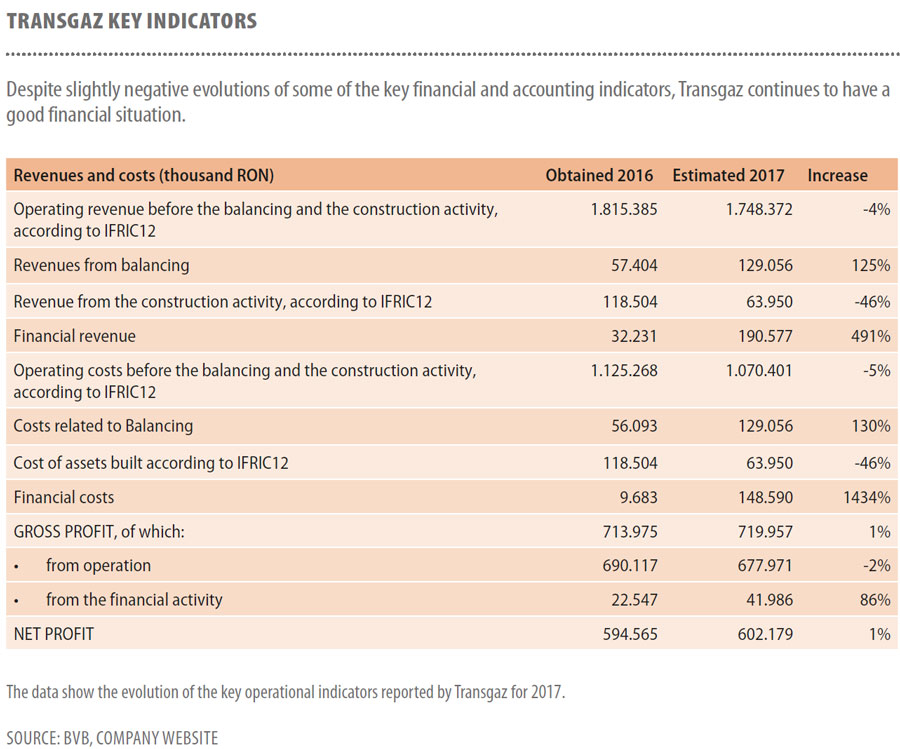
At the bottom of the ranking
While last year the less visible companies in the sector, such as Conpet (COTE), Oil Terminal and/or Rompetrol Well Services were the ones that brought spectacularity in financial evolutions (Conpet reported in 2016 a higher profit than in 2015, when it had a historical high profit, and Oil Terminal reported a profit of RON 15.4mln in 2016, by over 2.5 times higher than in the previous year), in 2017 their results, maybe as it was expected, are rather modest.
Thus, COTE – the national transmission operator for crude oil and petroleum products through pipelines and railways, reported for 2017 a declining turnover (from RON 381.6mln in 2016 to RON 376.6mln in 2017), amid sales worth around RON 411mln, at the same level as in the previous year. The company also reported a profit of RON 83.54mln, by only 4% higher than that achieved in 2016 (when the profit achieved was RON 71.5mln).
The total amount of volumes transported in 2017 reached 6,819.72 thousand tons, up 5.5% compared to the budgeted amount and down 3.7% compared to the amount transported in 2016, amid a lower demand for transmission services. Total revenues from transmission fell in 2017 by 2% compared to 2016, following the reduction of the total amount transported, according to another report, drawn up by the same company – BRK Financial Group, previously mentioned.
The report, available on BRK Financial Group’s website, also highlights that, in comparison with the proposed budget, revenues from transmission recorded an increase by 2.3% (plus RON 8.4mln). Specifically, in the country transmission subsystem the revenues from transmission fell by 3.8% in 2017 vs. 2016, while in the import transmission subsystem they grew by 6%.
On the other hand, the profitability of the company improved during 2017, BRK analysts also show. The operating profit increased by 4% and the net profit went up 3% compared to 2016, although the turnover plunged 1.4%. Compared to the budget provisions, EBITDA reached the level of RON 128.12mln, by 1.9% higher, mainly due to an increase in transmission revenues, they also say.
Oil Terminal, the largest operator at sea, specializing in the circulation of crude oil, liquid petroleum and petrochemical products and other products and raw materials, through import, export and transit, had an evolution downright disappointing. The company reported for 2017 a profit of only RON 5mln (in significant decline compared to the amount of RON 15mln reported in 2016), amid a decrease in turnover (from RON 161mln to RON 158mln). The turnover fell 1.6% compared to 2016, generated by the decrease by 4.6% of the physical program of services performed in 2017 compared to 2016, according to company’s report.
Unlike it, Rompetrol Well Services could be a pleasant surprise this year. The company seems to have overcome in 2017 the unfavourable context in which it evolved over the past two years (reporting losses of RON 30 million in 2015 and RON 6 million in 2016), and recording profit. Thus, the company posted in 2017 a net profit of around RON 2mln, at a turnover of around RON 40mln (in turn climbing by around 30% compared to the turnover posted in 2016). And this evolution seems to position it favourably for 2018.
Expectations and perspectives
The evolution of Rompetrol Well Services (PTR) – more precisely company’s profit amid an increase in turnover, may be a sign that the profile industry has finally and decisively overcome the crisis, entering a new growth cycle.
Moreover, such a perspective can also be supported by the expectations and estimates expressed by OMV Petrom officials regarding 2018, in the report in which the results for 2017 were published. Thus, OMV Petrom specialists estimate for 2018 an average Brent oil price of around USD 60/bbl and a demand in continuous growth for petroleum products. At the same time, they say, Romania will register in 2018 a demand for natural gas and electricity at least at the same level as in 2017. It is true that there could be new risks in terms of the legal framework on taxation and royalties – OMV Petrom specialists estimating that a new draft law on royalties will be put up for public debate this year.
On the other hand, the profile industry could – or should feel a positive boost given by a number of other events – such as the recently announced takeover by Transgaz of the company Vestmoldtransgaz from the Republic of Moldova, or a potential success of the approach through which the same Transgaz aims to take over (in a consortium) the similar operator in Greece, DESFA.


